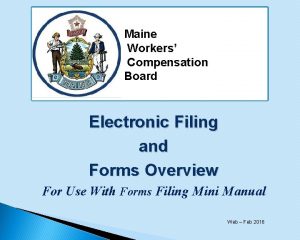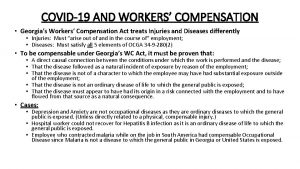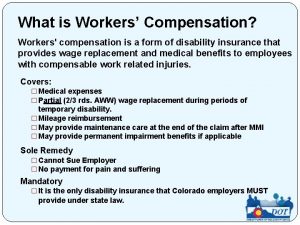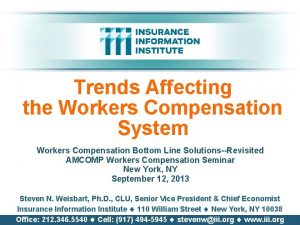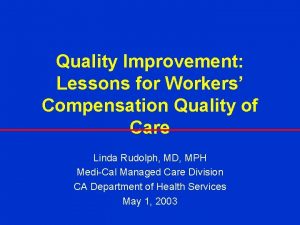DataTech 4 WORKERS COMPENSATION DATA QUALITY ISSUES CAS






















- Slides: 22

Data/Tech 4: WORKERS’ COMPENSATION DATA QUALITY ISSUES CAS Ratemaking Seminar March 10 -11, 2005 1

Discussion Topics The importance of data quality n The impact of poor quality on the WC system n The need for all parties involved to understand the importance of good data quality and the issues impacting the quality of data n 2

Discussion Topics (cont. ) n The state of data quality in the industry n Data quality successes and challenges n Underlying processes and procedures used by insurers and their trading partners that can negatively or positively impact data quality n Industry best practices around the collection and reporting of data n Potential improvements and next steps 3

Panelists Art Cadorine, Principal WC Services, ISO n Pete Marotta, Principal Data Management Consulting, ISO n Ia Hauck, Director & Actuary, Actuarial & Economic Services, NCCI n Bruce Tollefson, President MN WCIA n Tim Wisecarver, President, PA & DE CRB n 4

Data Quality Best Practices Guiding Principles: Data is a corporate asset n Data should be fit for the use intended n Data should flow from underlying business processes n Data quality should be managed as close to the source as possible n 5

Key Characteristics of Data Quality n Accuracy n Reasonableness n Validity n Avoid Redundancy n Timeliness n Accessibility & & Timing n Completeness/ Entirety Availability n Privacy 6

Workers Compensation Insurance Organizations (WCIO) n A voluntary association of statutorily authorized or licensed rating, advisory, or data service organizations that collect workers compensation insurance information n Provides a forum for exchange of information about workers compensation insurance n Develops standards for the electronic transmission of information between insurers and rating/advisory organizations 7

Setting the Stage n 2003 direct premiums written $50 billion (A. M. Best) n Over 4 million policies a year n Statutory coverage n Auditable line n Long tail line n Data reporting unique to WC n Aggregate financial data n Unit Statistical Reports (USR) n Detailed claim data n Injury (FROI/SROI) and proof of coverage 8

Types of Workers’ Compensation Data Collected n Financial Data n Annual Cycle, Little or No Classification, Policy or Claim Detail n Policy Information n Coverage, Exposure & Pricing Analysis, Triggers Unit Statistical Reports n Policy and Claim Level Detail, Experience Rating, Classification Pricing n Individual Case Reports n Quality Edits on Large Losses n Special Calls 9

State of Data Quality Checks and Balances Workers Compensation “Check and Balances”—All stakeholders have an interest in the completeness, accuracy, and timely reporting of data: n n n Insurance Companies—Loss Costs/Rate Filings Employers—Affordable and Available Coverage Workers—Safe Workplace, Benefits and Medical Coverage Data Collection Organizations—Credible and Reliable Estimates, Forecasts and Analyses Agents—Timely/Accurate Experience Ratings State Regulators—Rate Adequacy, Employer Coverage These individual interests contribute to the overall health and quality of the data that fuels the WC system 10

State of Data Quality Control Measures The Workers Compensation data reporting system provides an extensive complement of control measures that contribute to the overall level of quality n n n n n Data Reporting Standards, Rules and Training Timeliness Control Programs Online Reporting Tools Editing Processes Follow-Up Programs for Timeliness and Quality Issues Data Quality Monitoring and Validation Tests Incentive Programs Test Audit Programs NAIC Model Regulations State Regulatory Audits of DCOs and Carriers 11

State of Data Quality Industry Standards, Tools and Training Workers Compensation Organizations promote Data Standards, Tools and Training that lead to Data Quality Standards n n WCIO Data Specifications Manual Statistical Plans User’s Guides Rating Plans Provide… n n n Business Rules Common Data Definitions Standardized Reporting Formats Common Codes Editing Processes 12

State of Data Quality Industry Standards, Tools and Training Reporting Tools n n Web-based Reporting Applications Editing Packages Provide… n n Streamlined Reporting Processes Pre-edit Capabilities Training n n IDMA Data Management Courses WCIO Data Reporting Handbook DCO Sponsored Training and Workshops Industry Communications (Bulletins/Circulars) Provide… n n n Professionalism and Certifications Continuing Education Tailored Curriculums—New Staff, New Tools, Industry Developments, etc. 13

State of Data Quality Results State examinations of DCO’s confirm the overall accuracy of Workers Compensation data, the effectiveness of data quality programs, and: n All stakeholders involved in the “checks and balances” positively influence the timeliness and quality of our data n Established control measures contribute to the overall level of quality n Industry Standards, Tools and Training must continue to promote and reinforce the importance of data quality The Future—We need to continue to build on this data quality commitment, always looking to raise our collective expectations 14

Many Data Hand Offs n Employers n Other 3 rd party vendors n Agents/brokers Policy admin. vendors n Auditors n Medical service providers n Case mgmt. services n Law firms n Medical bill reviewers n Others n Mergers and acquisitions n Transfers of books of business n Transfers of books of claims n TPAs n Insurers n State Funds n Reinsurers n Data Collection Organizations (DCOs) n Accident Boards n Federal regulators n 15

Areas of Concern for Data Quality n The Vast Majority of Required Data is Reported Timely and Without Consequential Data Quality Issues n Where Problems Do Occur, They Reside in the Following General Areas: n n n Unreported Data Late Reported Data Invalid Data Incorrect Data Questionable Data 16

Unreported Data n Carrier Insolvencies n Unrecoverable Loss of Carrier Records 17

Late Reported Data n Carrier System Issues n Merger/Acquisition n Other n Risk or Unit Specific Issues 18

Invalid Data n Codes (Classification, Injury Description, etc. ) n Exposure Reported for Code Not Allowing Exposure n Invalid Classification Combination(s) n Unaudited or estimated payrolls 19

Incorrect Data n Rating Value Errors n Incorrect Premium Calculations for Statistical Codes n Anniversary Rating Date Errors n Accident Date Outside Policy Term 20

Questionable Data n Allocations of Exposures and/or Losses by Classification n Large Units with Zero Reported Losses n Claims with High Medical Losses, but No Indemnity 21

DISCUSSIONS, CONCLUSIONS & QUESTIONS 22
 Controlling workers compensation costs
Controlling workers compensation costs Texas hcn workers compensation
Texas hcn workers compensation Oregon workers compensation division
Oregon workers compensation division Maine workers compensation forms
Maine workers compensation forms Workers compensation fraud detection
Workers compensation fraud detection Liberty mutual insurance
Liberty mutual insurance Workers compensation puncture
Workers compensation puncture Maine workers compensation forms
Maine workers compensation forms Compensation and non compensation dimensions
Compensation and non compensation dimensions Global compensation issues
Global compensation issues What ethical issues surrounding executive compensation
What ethical issues surrounding executive compensation Data quality issues
Data quality issues Flexo print quality issues
Flexo print quality issues Ieee standard 1159
Ieee standard 1159 Data quality and data cleaning an overview
Data quality and data cleaning an overview Data quality and data cleaning an overview
Data quality and data cleaning an overview Secondary content analysis
Secondary content analysis Data quality and data cleaning an overview
Data quality and data cleaning an overview Quality control and quality assurance
Quality control and quality assurance Quality control vs quality assurance pmp
Quality control vs quality assurance pmp What are quality standards in project management
What are quality standards in project management Ana model of quality assurance
Ana model of quality assurance Quality improvement vs quality assurance
Quality improvement vs quality assurance







